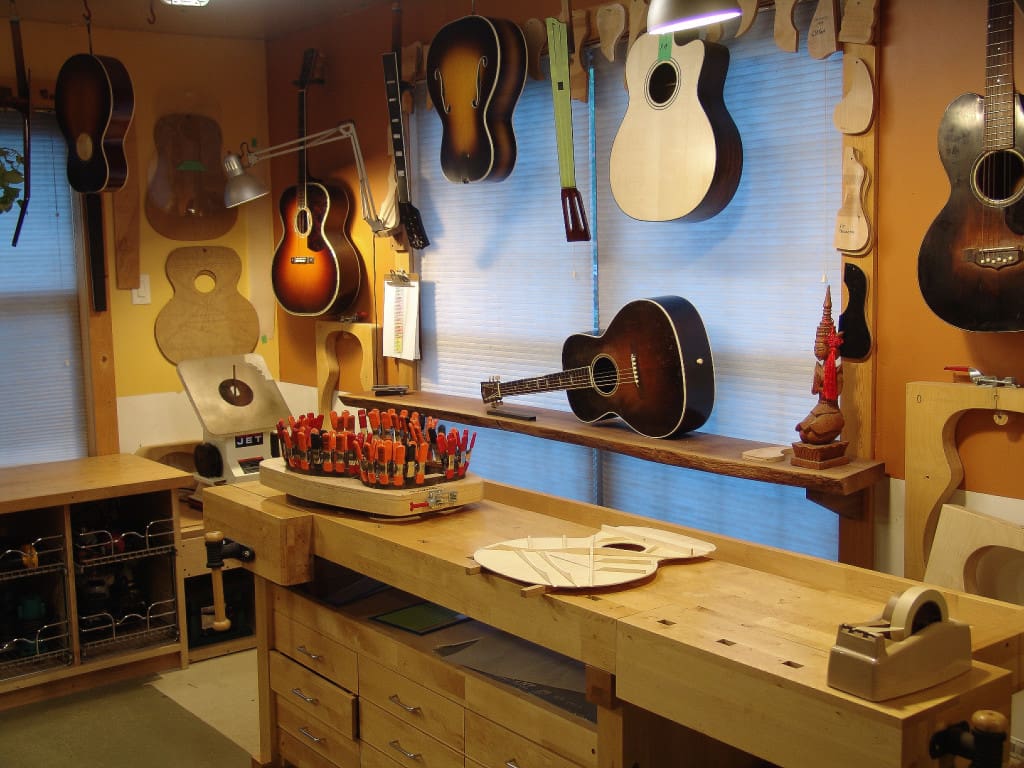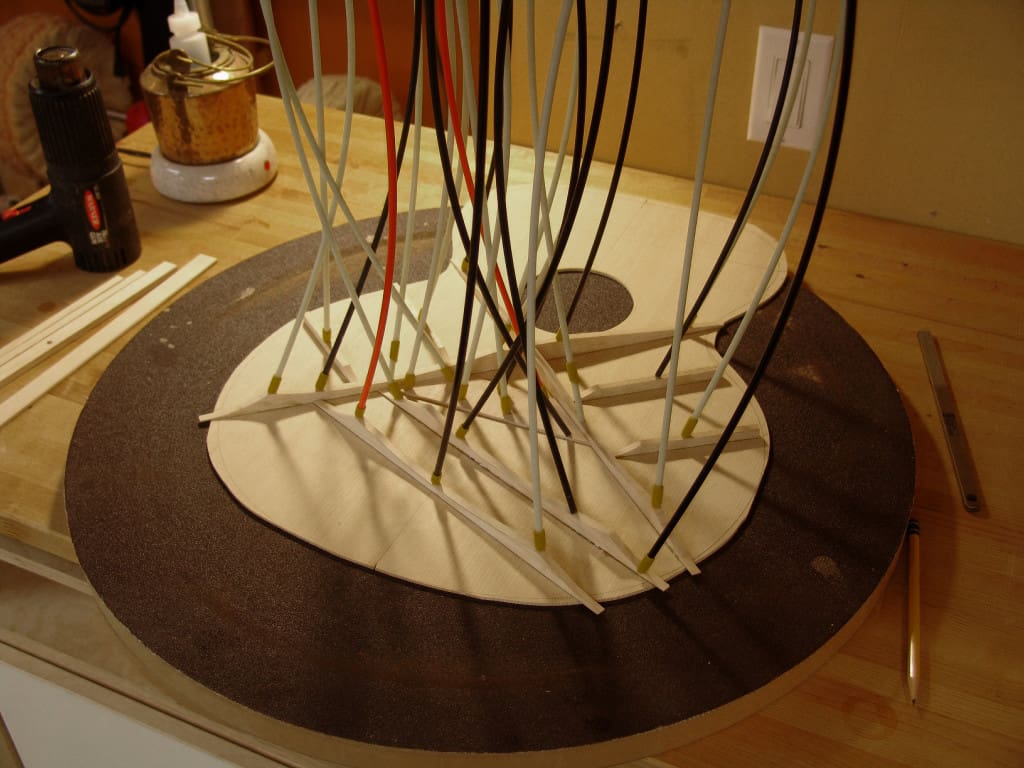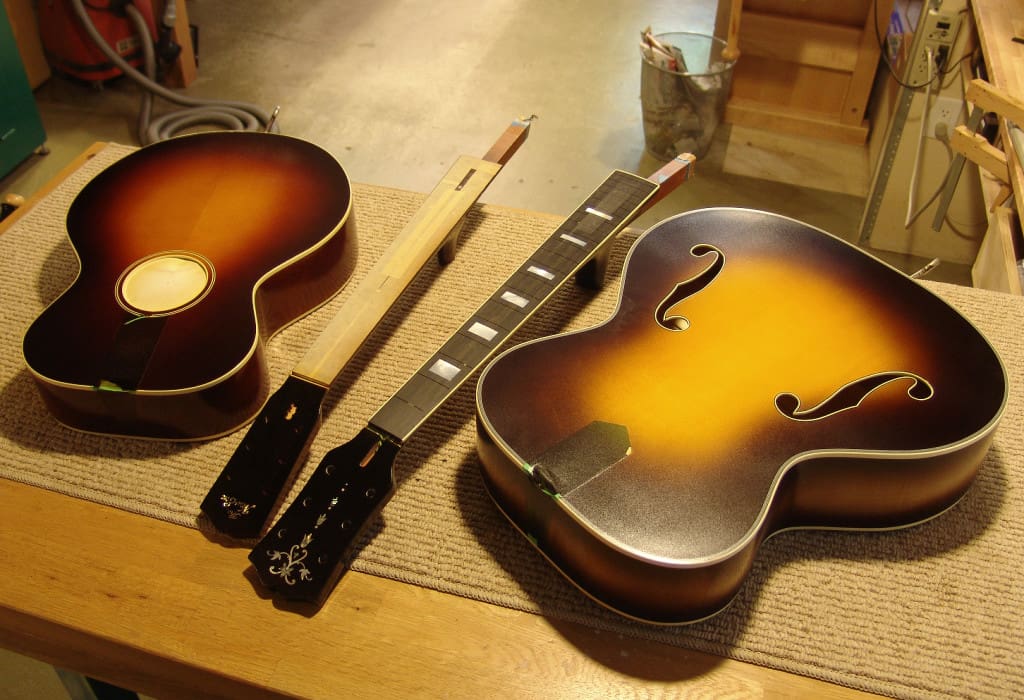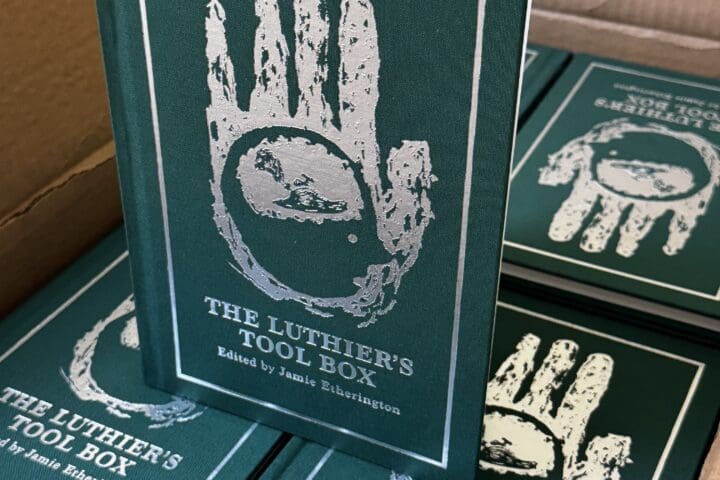In 1985, Tony Klassen drove to George Gruhn’s shop in Nashville with one purpose: to buy a fancy style 45 Martin. While perusing Gruhn’s shelves, he stumbled upon (and eventually bought) something else entirely, a Larson Brothers-built Euphonon. It captivated Klassen and would eventually change the course of his career.
Today, Klassen is a full-time luthier, building Larson-inspired instruments under the ARK New Era moniker. Beyond that, he’s begun building recreations of other, equally obscure vintage classics, including the flattop instruments built by Kel Kroydon, Regal and Bacon & Day (we interviewed Joe Henry a while back about his Klassen-built B&D Senorita).
It’s always refreshing to see a luthier make guitars that are decidedly not in the Gibson or Martin mold so we thought we’d check in with Klassen one more time for this week’s Bench Press. Here, he gives us an update on his latest projects and tells us a bit about what makes Larson instruments so magical.
Fretboard Journal: What are you working on right now?
Tony Klassen: I have three guitars in production at the moment. Two of the guitars that I’m working on will be new additions to my expanding lineup. The first one is the NE-1. This is the small body 1929 Gibson L-1, like the famous Robert Johnson guitar – small and a very light build. What I’m excited about on this one is the “A” braced top – a little different then the normal “X.” The second build is based on a very unique and rare Larson. It’s a 17″ Prairie State flat top with ‘f’ holes. It’s a typical Larson X bracing pattern with little modification to accommodate the two “f” holes. The neck is set back for a floating bridge and tailpiece. A crazy and cool Larson! The third guitar is a Senorita S6-12. A twelve-fret version with Ziricote back and sides.
FJ: Are these new builds (the NE-1, Prairie State, and 12-fret Senorita) commissioned or something you’ve been thinking about building for a while?
TK: The S6-12 (12 fret Senorita) is a commission. That’s a model Joe Henry helped me introduce and it has been available for a while now. The 2 new models I will be adding soon are the NE-1, which is based on a 1929 Gibson L-1, the famous Robert Johnson guitar. The other new model is the Prairie State “f” hole flat top, which is a Larson design. There are so many vintage guitars I think about building! But with my workload, I find it hard to make a guitar that isn’t on order. So when a customer asks me if I would be interested in making something different, it really gets me excited. Many of the guitar designs I offer I have been lucky to have owned at one time. That really helps as far as getting specs and the feel for a new build. But if something comes up that I haven’t had the pleasure of owning, I’m fortunate to have access to a few large collections.
FJ: Can you tell us about the wood and construction techniques you’re using for the instruments you’re currently building? Is anything unorthodox or new with this one?
TK: As far as techniques I’m really not doing anything new, and staying as close and true as I can to the building techniques of the mid-1930s. I offer hide glue as an option and prefer it. Adirondack is a must for my tops. Mahogany and maple are old standards for back and side woods. Unfortunately finding good rosewood is getting more difficult, but there are still some great choices. Madagascar and cocobolo are my favorites.
Many other species of rosewood are available and I’m sure I will be exploring them soon enough. The most unique construction feature of a Larson-made guitar is the laminated X bracing. They laminate the main X, and the transverse brace under the fingerboard extension with a spruce/rosewood/spruce combination. Their intent is for a much stronger top. This was patented in 1904! A bit unorthodox and ahead of their time for the steel string flattop guitar. The tops are also what they call “built under tension.” Meaning there is a slight arch to the top also adding more strength. So when it comes to a Larson build, I follow in their footsteps.
FJ: Where is your shop located?
TK: I’m located about an hour and a half east of Chicago. The area was known as Furnessville many years ago. It was also a place where many Chicago artists settled or had their studios. Most are gone now and seems I’m the only artist left. I must say it’s a very inspiring place for guitar building.
This part of the Midwest was at one time the mecca for guitar building. We have Chicago an hour and a half to the West; this is where the Larson and Regal guitars were made. An hour and a half to the East we have Kalamazoo, where the best Gibsons were made. Now here I am in the middle, so to speak. My favorite vintage guitars, and the ones I replicate, were all made within a very close proximity of each other! So I often ponder this location and climate and its effect on building guitars. Of course, in modern times, we have the luxury of heat, cooling, and humidification, but I often wonder how the harsh winters and summers have their effects. I guess this could be a whole other topic!
FJ: How did you get interested in building guitars and subsequently, how did you decide to do it for a living?
TK: It was a dream since my first Larson Brothers’ discovery in 1985, but it took 20-plus years before it became a reality. The mid-’80s were a new era for guitar makers. Martin and Gibson held the markets, but there were some up-and-coming luthiers: Lowden, Collings and Taylor, to name a few. At that point, I thought, “Why isn’t anyone making guitars like the Larson’s did?”
My background and education is in Graphic Design and I have always had a strong interest in woodworking. I grew up around tools in my grandfather’s shop, so learning how to use them came pretty easy. In the Fall of 1987, after about four years in design, an opportunity to relocate to Northwestern Connecticut and work in a small high-end furniture shop presented itself. So I quit my job, packed up everything I owned in a tiny U-Haul (including my most prized possession, the Euphonon) and headed east not really knowing what would happen. It was a very exciting time. I totally felt at home in the shop. Woodworking seemed to be my calling. It came pretty naturally. The shop and the access to all those woodworking tools inspired me to make my first guitar.
I didn’t really know where to start. I had an article from Fine Woodworking on how to bend sides, and I owned a book a friend have given me years ago on guitarmaking by David Russell Young. Everything you need, right? I found a guitarmaker’s supplier in New Hampshire, got my supplies and dove right in headfirst! I spent many after hours and weekends in the shop. Always with my trusty Euphonon at my side. I used it as my model and guide. I don’t recall how many hours went into my first guitar, but I did finally string it up… something I will never to this day forget! With that first guitar, I wondered why there weren’t more Larson-inspired guitarmakers out there. Unfortunately, as fate would have it, it was time to leave Connecticut, and back on that road to discovery! I ended up in Chicago, and back into the Graphic Design industry.
The late 1980s and 1990s were a booming time in the Graphic Design field. The computer emerged and changed everything, and the way designers thought. I started my own business. The money was great, and jobs were a plenty. That would all abruptly change with the major fall in the economy in about 2001. So my business ended. Now what? As a hobby over the years, I had collected woodworking tools and converted my two-car garage into a pretty nice woodshop. I dabbled in furniture making, but found quickly there was no market in my area for handmade furniture. I found myself slowly selling off my collection of Larsons just to pay the bills. So my next adventure was a big one. I decided it was now finally time to do what I really love and cast my fate to the wind. In the spring of 2005, I dove in headfirst. For my first instruments, I got into some of my favorite guitar shops. They were met with great enthusiasm, so I was delighted. I put my design skills to work and got my website up and running. I’m now well into my fifth year with 92 guitars built to date, and a build list two years out. I owe it to my love of the craft, hard work, and most importantly, perseverance.
FJ: How much time do you spend building an average guitar?
TK: I build approximately 15 guitars a year, and I spend on average about 6 weeks per guitar. Typically, but not always, I will build in batches of two. While one batch is in the finish room, another batch is on the workbench.
FJ: Any specific instruments from your past you want to mention?
TK: That would have to be anything vintage since it’s the drive behind what I do. Most of what I build is reproductions of guitars produced from 1929 – 1939, the “Golden Era.” Over the years I have had many a fine vintage guitar. 90% of the [original] models in my offerings I was lucky enough to have owned. That gave me a great deal of time spent playing them, getting the feel, and absorbing their energy. I owe it all to vintage and I couldn’t do what I do without that experience. It’s tough, but if I had to pick three favorites they would be my 1930 Gibson Nick Lucas, a 1936 Bacon & Day Senorita (the famous John Fahey guitar), and my old 1937 Euphonon.
FJ: Anything coming up in the future you are particularly excited about?
TK: My favorites are my signature models. Nothing more exciting than making a guitar for one of your guitar heroes and having his name on it. Coming up this Fall/Winter, there will be a Joe Henry signature model that Joe and I are working on. Joe’s preferences are twelve-fret guitars. I recently made him a Senorita that he requested in a 12-fret version. So a bit of reworking there and the end results were quite satisfying. Joe’s signature model we are currently designing will be based on a rare Chicago-made Regal from 1936, the Tonk Brother’s-era. It will of course be a 12 fretter and the headstock will have a logo of the guitar’s name that Joe chose, The Bellwether.
FJ: What has it been like working with Joe Henry on a creative level?
TK: It’s been a real pleasure working with Joe. He loves my work, and often will give me little updates on the guitars, his travels, recordings and the people who get to play them. It’s very exciting for me. Our first project together was taking the Senorita S-6 and converting it to a 12-fret version. Without Joe’s input, I don’t think I would have ventured to do this. The outcome was pretty amazing and really changed the tone of the Senorita. Mellow, deep and responsive. Our next project will be another 12-fret configuration of a 1930s Tonk Washburn. I can’t wait!
FJ: Has having a signature artist helped sales?
TK: Yes. Joe travels and plays them in his shows so the exposure is there. I already have orders for a couple of his signature model and we haven’t even nailed down the design yet!






